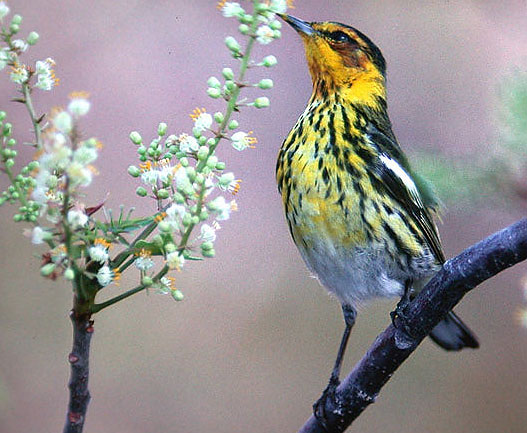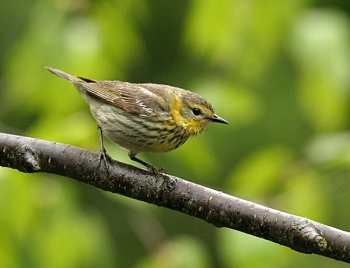BigRedBirder (talk | contribs) |
(→External Links: Multiple GSearches combined) |
||
| (15 intermediate revisions by 6 users not shown) | |||
| Line 1: | Line 1: | ||
| − | + | [[Image:Cape_May_Warbler.jpg|thumb|550px|right|Photo © by {{user|Doug+Greenberg|Doug Greenberg}}<br />Fort Jefferson, Dry Tortugas, [[Florida]], April 1990]] | |
| − | [[Image:Cape_May_Warbler.jpg|thumb|550px|right|Photo by Doug Greenberg<br/> | + | ;[[:Category:Setophaga|Setophaga]] tigrina |
| − | + | ''Dendroica tigrina'' | |
| − | + | ==Identification== | |
| − | ====Breeding Male | + | '''Breeding Male''': |
*Brown back | *Brown back | ||
*Yellowish rump | *Yellowish rump | ||
| Line 11: | Line 11: | ||
*Blackish wings and tail edged olive | *Blackish wings and tail edged olive | ||
*White tail spots | *White tail spots | ||
| + | [[Image:2288IMG 2559capemayfembf.jpg|thumb|350px|right|Female<br />Photo © by {{user|Kent|Kent}}<br />[[Minnesota]], [[USA]], June 2004]] | ||
*White vent and undertail coverts | *White vent and undertail coverts | ||
*Bright yellow throat and nape | *Bright yellow throat and nape | ||
| Line 16: | Line 17: | ||
*Black eyestripe | *Black eyestripe | ||
*Narrow white wing bar | *Narrow white wing bar | ||
| − | *Sharply pointed bill | + | *Sharply pointed bill<br /> |
| − | + | '''Female and Immature''' | |
*Washed out versions of breeding male | *Washed out versions of breeding male | ||
*Lack strong head pattern | *Lack strong head pattern | ||
*Yellowish rump | *Yellowish rump | ||
*Weak white wing bars always present | *Weak white wing bars always present | ||
| + | ==Distribution== | ||
| + | Breeds in [[Canada]] from northeastern [[British Columbia]], southern [[Northwest Territories]] and northern and central [[Saskatchewan]] east to eastern [[Quebec]], [[New Brunswick]], and [[Nova Scotia]]; in the [[United States]] in northern [[Minnesota]], northern [[Michigan]], northern [[Vermont]], northern [[New Hampshire]], most of [[Maine]], and in a very small area in the Adirondacks of [[New York]]. It is migratory, wintering in the [[West Indies]]. | ||
| − | == | + | Rare to casual vagrant to [[Alaska]] and the western [[United States]]. Accidental vagrant to [[Great Britain]]. |
| − | + | ==Taxonomy== | |
| + | This is a [[Dictionary_M-O#M|monotypic]] species<sup>[[#References|[1]]]</sup>.<br /> | ||
| + | Formerly placed in genus [[:Category:Dendroica|Dendroica]]. | ||
| − | |||
==Habitat== | ==Habitat== | ||
The breeding habitat is the edges of coniferous woodland, especially Black Spruce. | The breeding habitat is the edges of coniferous woodland, especially Black Spruce. | ||
| − | == | + | ==Behaviour== |
| − | + | ====Breeding==== | |
| − | ==== | + | They nest in dense foliage near the trunk of a conifer, laying 4-9 eggs in a cup nest. |
| − | |||
====Diet==== | ====Diet==== | ||
Insectivorous, and lay larger clutches in years when Spruce Budworm is abundant. They pick insects from the tips of conifer branches or fly out to catch insects in flight. They also feed on berry juice and nectar in winter, and have, uniquely for a warbler, a tubular tongue to facilitate this. | Insectivorous, and lay larger clutches in years when Spruce Budworm is abundant. They pick insects from the tips of conifer branches or fly out to catch insects in flight. They also feed on berry juice and nectar in winter, and have, uniquely for a warbler, a tubular tongue to facilitate this. | ||
| + | ====Vocalisation==== | ||
| + | Usually sings from high perches.<br /> | ||
| + | '''Song''': Very high and thin; may sound slightly buzzy; four to seven unslurred notes (5/second) ''seet seet seet seet seet'' or slightly lower-pitched, faster, more complex ''seeo seeo seeo seeo seeo'' or ''witse witse witse wit''<br /> | ||
| + | '''Call''': A very high, hard, short ''te'', or a thin ''sip''.<br/> | ||
| + | '''Flight call''': a very high, slightly buzzy ''tzew'' or ''tzee'' slightly descending. | ||
| + | ==References== | ||
| + | #{{Ref-Clements6thAug11}}#Avibase | ||
| + | {{ref}} | ||
| + | ==External Links== | ||
| + | {{GSearch|"Setophaga tigrina" {{!}} "Dendroica tigrina" {{!}} "Cape May Warbler"}} | ||
| + | {{GS-checked}}1 | ||
| + | <br /> | ||
| + | <br /> | ||
| − | + | [[Category:Birds]] [[Category:Setophaga]] | |
| − | |||
| − | |||
| − | |||
| − | |||
| − | |||
| − | |||
| − | |||
| − | |||
| − | |||
| − | [[Category:Birds]] | ||
Latest revision as of 20:22, 4 February 2023
- Setophaga tigrina
Dendroica tigrina
Identification
Breeding Male:
- Brown back
- Yellowish rump
- Dark brown crown
- Yellow underparts
- Heavily streaked black on lower throat, chest and flanks
- Blackish wings and tail edged olive
- White tail spots
- White vent and undertail coverts
- Bright yellow throat and nape
- Chestnut auricular patch
- Black eyestripe
- Narrow white wing bar
- Sharply pointed bill
Female and Immature
- Washed out versions of breeding male
- Lack strong head pattern
- Yellowish rump
- Weak white wing bars always present
Distribution
Breeds in Canada from northeastern British Columbia, southern Northwest Territories and northern and central Saskatchewan east to eastern Quebec, New Brunswick, and Nova Scotia; in the United States in northern Minnesota, northern Michigan, northern Vermont, northern New Hampshire, most of Maine, and in a very small area in the Adirondacks of New York. It is migratory, wintering in the West Indies.
Rare to casual vagrant to Alaska and the western United States. Accidental vagrant to Great Britain.
Taxonomy
This is a monotypic species[1].
Formerly placed in genus Dendroica.
Habitat
The breeding habitat is the edges of coniferous woodland, especially Black Spruce.
Behaviour
Breeding
They nest in dense foliage near the trunk of a conifer, laying 4-9 eggs in a cup nest.
Diet
Insectivorous, and lay larger clutches in years when Spruce Budworm is abundant. They pick insects from the tips of conifer branches or fly out to catch insects in flight. They also feed on berry juice and nectar in winter, and have, uniquely for a warbler, a tubular tongue to facilitate this.
Vocalisation
Usually sings from high perches.
Song: Very high and thin; may sound slightly buzzy; four to seven unslurred notes (5/second) seet seet seet seet seet or slightly lower-pitched, faster, more complex seeo seeo seeo seeo seeo or witse witse witse wit
Call: A very high, hard, short te, or a thin sip.
Flight call: a very high, slightly buzzy tzew or tzee slightly descending.
References
- Clements, JF. 2011. The Clements Checklist of Birds of the World. 6th ed., with updates to August 2011. Ithaca: Cornell Univ. Press. ISBN 978-0801445019. Spreadsheet available at http://www.birds.cornell.edu/clementschecklist/downloadable-clements-checklist
- Avibase
Recommended Citation
- BirdForum Opus contributors. (2024) Cape May Warbler. In: BirdForum, the forum for wild birds and birding. Retrieved 12 May 2024 from https://www.birdforum.net/opus/Cape_May_Warbler
External Links
GSearch checked for 2020 platform.1





